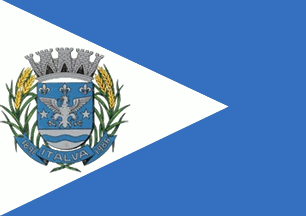 image located by Dirk Schönberger,
17 October 2011
image located by Dirk Schönberger,
17 October 2011Source: http://www.italva.rj.gov.br/portalitalva/index.php/portalitalva/municipiobandeira

Last modified: 2012-03-28 by ian macdonald
Keywords: rio de janeiro | italva |
Links: FOTW homepage |
search |
disclaimer and copyright |
write us |
mirrors
 image located by Dirk Schönberger,
17 October 2011
image located by Dirk Schönberger,
17 October 2011
Source:
http://www.italva.rj.gov.br/portalitalva/index.php/portalitalva/municipiobandeira
Official website at
http://www.italva.rj.gov.br/portalitalva.
Dirk Schönberger, 17
October 2011
The municipality of Italva (14,063 inhabitants in 2010; 297 sq. km) is located in northeast Rio de Janeiro State, 350 km of Rio de Janeiro. The municipality is made of the town of Italva proper and of the districts of Paraíso, Lagarto and Dr. Mattos. Italva was originally founded as Santo Antônio das Cachoeiras, established by Provincial Law on 6 November 1873 and made a district of the municipality of Campos on 10 August 1891. The settlement was subsequently renamed Cachoeiras ("Waterfalls") and, on 6 January 1917, Cachoeiras do Muriaé, as a tribute to the profuse water of river Muriaé. State Law of 29 December 1930 renamed the place Monção, some say to honor a local family, other say to evoke the local light breeze ("monção" means "monsoon" in Portuguese). The name of Italva was proposed (and adopted in 1943) by Jacy Pereira de Oliveira, referring to Guarani-Tupi words meaning "white stone", as a tribute to marble showing on the surface in the municipal territory. Marble and limestone extraction is still the main industry in Italva, represented by the "Indústria de Mármores Italva Ltda." (IMIL), "Indústria e Comércio de Cal e Calcário Maravilha" and "Calcário Paraíso e a Alternativa Granitos" (CALPAR) companies, among other. Italba is self-styled "The Capital of Marble, Lime, Limestone and Kibbeh", kibbeh alluding to the significant numbers of inhabitants of Lebanese and Syrian origins. The municipality of Italva was established by State Law No. 999 of 12 June 1986, seceding from Campos dos Goitacazes, and inaugurated on 31 December 1986.
The symbols of Italva, designed by the heraldist and vexillologist Lauro Ribeiro Escobar, are prescribed by Municipal Law No. 6 of 26 February 1987.
The flag uses the municipal colors, chosen as the colors of the Virgin Mary, the patron saint of Italva. The white triangle charged with the municipal coat of arms represents the effort to reach a promising and progressing future.
The coat of arms is made of an Iberian shield, "Azure an eagles
surrounded by two stars and ensigned by two fleurs-de-lis all argent
the base of the second a fess wavy of the first. The shield surmounted
with an eight-towered mural crown argent ports sable. The shield
supported by rice plants leaved and fructed proper. Below the shield a
scroll azure inscribed in letters argent '1891 ITALVA 1896' ".
The Iberian shield, used in Portugal when Brazil was discovered,
recalls the early colonists of the country. Azure (blue), the symbol
of justice, beauty, sweetness, nobleness, incorruptible firmness,
dignity, zeal and loyalty, represents the natural beauty of the region
and the virtue of its inhabitants and administrators.
The eagle, standing for power, prosperity, high views, great
initiatives and triumph, represents the duty of the inhabitants and
administrators to triumph from all obstacles hindering the development
of the municipality.
The stars represent light in the night, a safe guidance, aspiration to
high ideals and sublime acts, a brilliant future, therefore completing
the symbolism of the eagle and predicting a bright and prosperous
future for the municipality, under the administrators' guidance.
The fleur-de-lis is the attribute of the Virgin Mary, the patron saint
of Italva.
The base of the shield symbolizes the ground and underground resources
of the soil, rich in marble and limestone. Argent symbolizes felicity,
purity, temperance, truth, frankness, integrity and friendship. The
fess wavy represents river Muriaé watering Italva.
The mural crown stands for a "cidade"; its open ports represents the
hospitality of the inhabitants of Italva.
The rice plants recall the fertility of the soil; rice is a
significant source of income for the municipality.
The scroll is charges with the years of foundation ("1891") and
political emancipation ("1986") of Italva.
http://www.italva.rj.gov.br/portalitalva/index.php/portalitalva/municipiobandeira - Municipal website (flag)
http://www.italva.rj.gov.br/portalitalva/index.php/portalitalva/municipiobrasao - Municipal website (coat of arms)
Ivan Sache, 13 March 2012